Contents
PPE
For any accident prevention work, engineering control is the best control, and aid of personal protective equipment (PPE) should be the last resort or a supplementary control.
Nevertheless, the importance of personal protective equipment (PPE in short) is not less, its scope and utility have been tremendously increased during the last few years and wide varieties of such equipment are available in the market.
This requires a proper selection of quality and utility for a specific purpose. The problem is not of the availability but is of its use by workers on the shop floors.
Particularly in a country ours where the majority of workers are illiterate, not safety conscious, and not trained to wear such equipment the problem becomes more acute mostly in small and medium-scale factories.
The statistics of accidents exclusively due to non-use, misuse or defects of PPE is not available as there is no such distinct accident classification. 33% of total accidents could have been prevented by the effective use of PPE.
CLICK HERE FOR 👉 HAZARD IDENTIFICATION & RISK ASSESSMENT (HIRA)
The conclusion is that @30 to 40% of total accidents can be prevented or controlled by the proper use of personal protective equipment. This figure is not small and highlights the need for PPE.
The PPE provides good defense against hazards of toxic exposure, oxygen deficiency, dusting, chemical splashes, steam, water and liquids, flying particles, hot substances, radiation, sharp edges, welding, cutting, grinding, striking against and stepping over objects, glare, personal falls and injury due to falling bodies, noise, scarp cleaning, material handling, the opening of pipelines or any hazardous work, electric shocks, burn and firefighting.
Many fatal accidents are caused due to these reasons and the use of appropriate PPE can prevent or lessen many of them.
The limitation of the protection by PPE should be well understood. Respirators have limited use for the concentration and time mentioned by the manufacturer. they cannot be used in higher concentrations for the longest time.
In heavy concentration, only a self-breathing apparatus (SBA) is recommended and that too for a limited time. Instead of providing hood and suction on flying particles, there is no meaning of giving respirators to the worker.
Instead of providing a guard on a grinding wheel, it is meaningless to provide eye protection to workers. Instead of sealing leakage of gas or dust or allowing it to continue, it is unsafe to advise the worker to use a gas mask.
CLICK HERE FOR 👉GRINDING SAFETY
Similarly, instead of trying to reduce pollution, it is of no use to tell the workers to use PPE only. It is always safer to improve the working conditions by engineering controls first. Then only the use of PPE may be recommended. It is the last line of defense.
PPE is the last line of defense. The first line is to eliminate or minimize workplace hazards. PPE cannot eliminate the hazard, it can help eliminate an injury or reduce its severity.
I remember a few fatal accidents from my investigation where I was of the opinion that besides engineering controls, PPE could have prevented such accidents.
When an engineering control fails or becomes ineffective, what is the protection? Then this line of defense (i.e.PPE) comes to help and protect in most of the cases.
In one case a worker died due to phosphine exposure and in another case due to chloroform vapor in a tank. In the third case due to a splash of 2-4 dichlorophenol, a worker died within 15 minutes.
In still another case a worker died due to pesticide exposure in delayed effect. All four were young workers and died due to these toxic chemicals. If they would have worn appropriate PPE, they could have been survived.
This shows the significance of the need for PPE. Through PPE cannot eliminate the hazard (like engineering control) it can certainly protect from it.
CLICK HERE FOR 👉 NEAR-MISS EXAMPLE
The need for PPE can be well judged from:
- Visual and foreseeable hazards.
- Accident experiences.
- Report on the safety committee/representatives.
- Safety audits, surveys, sampling, job safety analysis, and risk assessment.
- Legal requirements and remarks of the authorities.
The need for PPE exists because:
- Chances of failure of engineering controls, materials, process, equipment, and safety devices cannot be denied and in those circumstances, the PPE can act as a barrier between the man and hazard and save from the injury.
- There are certain operations or accidental situations where engineering controls are less possible and PPE becomes necessary. For repair or maintenance or to enter into a toxic or oxygen-deficient atmosphere, or while working at height or doing jobs like welding, cutting grinding, chipping, PPE gives good protection.
- It effectively avoids the contact of dangerous substances, noise, vibration, and radiation.
- It protects from atmospheric contaminants.
- It is a legal as well as moral duty to provide suitable PPE.
STATUTORY PROVISIONS FOR SAFETY
No specific personal protective equipment is named by the Factories Act, but working conditions mentioned in sections 14, 30, 33, 35, 36, 37, 38, 87, 111, and 114 are such that free of charge PPE should be provided by the occupier for the protection from hazards due to dust, fume, gas, vapor, flying particles, glare, revolving machinery, hot or dangerous contents, entry in confined space, explosive or flammable atmosphere, fire, dangerous operations, and hazardous process.
CLICK HERE FOR 👉 FACTORY ACT IN PDF
Rules prescribed under the above sections provide further details. 27 schedules of Rule 102 of the Gujarat Factories Rules indicate the need for PPE at many places.
Duty is cast upon the workers not to willfully neglect to make use of such equipment and not to interfere with or misuse them. Model Rule 58 u/s 35 and Model Rule 95 u/s 87 also prescribe PPE for the specific process.
Rule 68B, GFR states that the PPE shall conform to the Indian Standards. OSHA standards prescribe tremendous details for PPE. Noise-induced hearing loss is an occupational disease under the 3rd Schedule of the Factories Act. Schedule 23 u/r 102, GFR requires noise reduction below 90 dBA or to provide ear protectors to workers and their auditory examination by the doctor. Sch. 27 required protection against cotton dust.
INDIAN STANDARDS FOR PPE, CLICK BELOW BUTTON FOR MORE INFORMATION
SELECTION AND CLASSIFICATION OF PPE
Once it is decided that PPE is needed
- Select the proper type of equipment (IS mentioned in Part 3 should be referred to) and then
- Make sure that the supervisor sees to it that the workers use and maintains it correctly.
- Proper selection, training, and use of PPE are essential.
Factors of selection or requisite characteristics of PPE are:
- It should give adequate protection against the nature, severity, and type of hazard.
- Make sure that the supervisor sees to it that the worker uses and maintains it correctly. Proper selection, training, and use of PPE are essential.
Factors of selection or requisite characteristics of PPE are:
- It should give adequate protection against the nature, severity, and type of hazard.
- It should be of minimum weight, should give minimum discomfort with protective efficiency.
- Attachment to the body should be flexible yet effective.
- The wearer should not be restricted in movement or perceptions required for the job.
- It should be durable and attractive.
- It should not cause any hazard through its material, design, defect, use, or failure.
- It should conform to Indian Standards and the tests required.
- It should be easy to clean, repair, and maintain. The parts, pieces, and services should be easily available.
If all the above criteria are not available effort should be made to get the maximum of them.
CLICK HERE FOR 👉 SOP FULL FORM
Respiratory (Breathing) PPE:
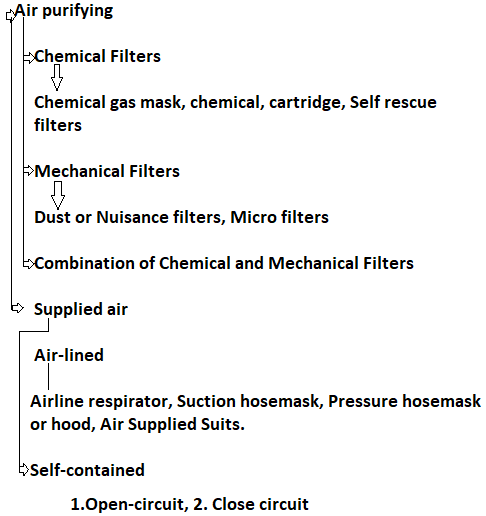
Selection and Classification of PPE according to the body part and hazards:
| Body part | Hazard | PPE necessary |
| Head | Falling objects, Shock, chemical spurting | Safety helmet, hard hats, safety caps, headgear |
| Eye | Chemical splash, dust, flying particles, gas, welding, radiation. | Spectacles, lenses, and goggles for chemical, welding, grinding, furnace, dust, etc. |
| Ear | High-level noise (>90 dB) | Earmuffs, earplugs, inserts |
| Nose | Dust, toxic gases | Dust mask, cloth mask, rubber mask, fume mask, respirators for dust, gas, and vapor, rescuer plus pressure suit, breathing apparatus (O2 or Air), Canister gas masks, airline respirators, chemical/mechanical filters. |
| Face | Chemical splash, flying objects, hot substance. | Face shield, welding screen, furnace mask, faceguard. |
| Hand | Hot substance, acid, alkali, pigments, chemical, handling, cut, sharp edge. | Hand gloves of rubber, PVC, hosiery cotton, leather, canvas, fiberglass, electrical rubber gloves, arm sleeves. |
| Body | Chemicals, splashes, hot substances, fire, handling. | Aprons, coats, and pants, pressure suit, suit of rubber, PVC, etc. |
| Foot/Leg | Striking against objects, chemicals, falling bodies | Leather or rubber sole shoes, steel toe-boots, antiskid sole shoes, ammunition boots, gumboots, leg sleeves. |
| Overall | Falling from heights, hurt by falling bodies, chemicals. | Safety belts, pole strap belt, nylon safety harness, all-purpose safety harness belt, vertical lift safety harness, Boatswain’s chair, rope ladders, nets, safety hooks. |
Selection and classification of Respiratory equipment based on the type of hazard:
Selection of Material of Construction for PPE
| No. | Material | For the protection from |
| 1. | Metal | Flying particles, Falling body, sharp edge, abrasion |
| 2. | Fibre-metal | Sparks, a falling body, flying particles, sharp edge, abrasion machinery |
| 3. | Metal screen | Sharp edge & abrasion |
| 4. | Plastic, PVC | Hot liquid, moisture, water, acid, alkali, electric shock, skin protection, petroleum |
| 5. | Rubber | Hot liquid, moisture, water, acid, alkali, electrical shock, machinery, skin protection |
| 6. | Conductive rubber | Explosive substance |
| 7. | Chrome leather | Hot substance, flying particles, sharp edge, abrasion, sparks |
| 8. | Canvas | Flying particles, sharp edge, abrasion, machinery |
| 9. | Asbestos | Heat, hot substance, sparks |
| 10. | Acidproof fabric | Acid & alkali |
| 11. | Reflective fabric | Hot liquid |
| 12. | Flameproof duck | Heat, hot substance, sparks, chemicals, flying particles, machinery |
| 13. | Cotton wool | Heat, sparks, machinery, skin protection |
| 14. | Cotton canvas | Sharp edge & abrasion |
| 15. | Steel toe boot | Falling body, striking |
| 16. | Non-skid shoes | Moisture, slippery surface |
| 17. | Wooden sole boot or sandal | Heat, hot substance, moisture, water, acid, alkali, slippery surface, sharp edge, abrasion |
| 18. | Soft silicon rubber or plastic | Molded type earplug |
| 19. | Plastic goggles with the hydrophilic coating | To prevent fogging |
| 20. | Wire screen lenses (face shield) | Heavy fog or dampness |
| 21. | Laser safety goggles ( Anti laser eye shield) | Laser beams |
| 22. | Aluminized welding helmet | Infrared rays and to reduce heat effects. |
| 23. | Polarizing lenses (filter shade lenses) | To prevent glare |
| 24. | Steel reinforced plastic & hard rubber | Safety toe boot for foot protection |
| 25. | Boot with non-ferrous coating and conductive sole | Static charge, friction, sparks, and to reduce fire and explosion possibility. |
| 26. | Congress or gaiter type shoes | Work with hot metal in foundry, quick removable shoes without the lash. |
| 27. | Non-conductive or insulating (non-metallic shoes) | Electric work |
| 28. | Flexible metal-reinforced sole or inner sole | Construction work and cold metalwork with the possibility of foot injury Pharmaceutical factories needing higher product safety. |
| 29. | Plastic shoe cover or cap | Pharmaceutical factories needing higher product safety. |
| 30. | Specially made asbestos clothing | To work with hot metal up to 1650 degree centigrade |
| 31. | Aluminized asbestos or glass fiber and wool lining | To work near a furnace at a temperature up to 540-degree centigrade or for firefighting. Such proximity clothing should not be utilized to enter into the fire. They are for working from a distance. |
| 32. | Flameproof or flame-resistant cloth- THPC, Nomex or Modacrylic fabrics | Fireproof cloths to work in the fire flames. |
| 33. | Cushion pads or padded ducks | To carry the heavy or sharp-edged load on the shoulder or back. |
| 34. | The apron of padded leather, fabric, plastic, hard fiber or metal | For the protection of the abdomen or middle body parts. |
| 35. | Thermal net cotton or quilted material (dacron or nylon) | To work in cold weather (unsuitable to work in the fire). |
| 36. | High visibility and night hazard clothing | For construction and maintenance, Police and Fire brigade and Traffic hazards. |
| 37. | Disposable | In less radioactive work or drug or electronic industry. |
| 38. | Leaded clothing (lead glass fiber, leaded plastic) | Laboratory work, protection against X and Gamma rays |
| 39. | Electromagnetic radiation suit | Radar field |
| 40. | Conductive clothing | For lineman to work at extra-high-voltage. Such clothing keeps the linemen at the proper potential. |
NON RESPIRATORY PPE EQUIPMENT
Head and Hair Protection
Head protectors are hard hats, caps, and helmets made of aluminum, PVC fiberglass, laminated plastic or vulcanized fiber.
They may be fitted with brackets for fixing welding masks, protective face screen or a lamp. The hats and caps are provided with the replaceable harness which provides sufficient clearance between the top of the head and shell.
CLICK HERE FOR 👉 GAS CUTTING AND WELDING SAFETY
CLICK HERE FOR 👉 BACKFIRE/FLASHBACK SAFETY IN GAS CUTTING
Selection is as follows:
| Material | Protects against | |
| 1. | Fiberglass | Sparks, hot materials, heat |
| 2. | Plastic rubber | Hot liquids, moisture, acids, alkalis, electric shocks, dermatitis |
| 3. | Cotton wool | Sparks and heat, dermatitis, machinery |
| 4. | Metal | Falling objects, flying particles, cuts, abrasions. |
| 5. | Plastic | Sparks, falling objects, flying particles, electric shock, cut, abrasions. |
HEAD PROTECTION PPE

EYE PROTECTION PPE

FACE PROTECTION PPE

EAR PROTECTION PPE

HAND PROTECTION PPE

FEET PROTECTION PPE

BODY PROTECTION PPE
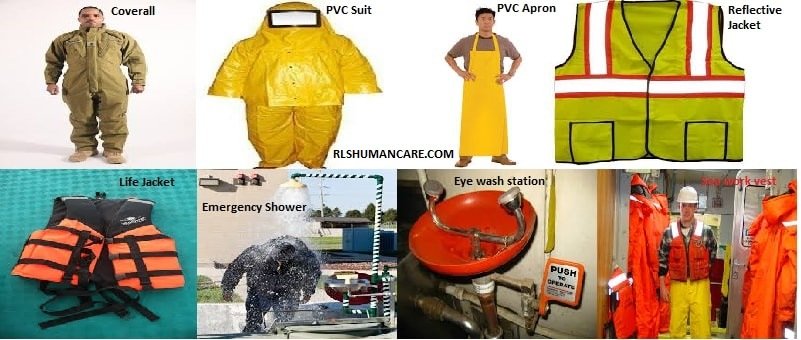
FALL PROTECTION PPE

RESPIRATORY PROTECTION PPE

Utility and characteristics of head protectors PPE are:
| Type | Protects Against | Characteristics |
| Safety Helmet | Falling objects, hitting against obstructions such as low ceilings, beams, scaffold members, etc. | Generally made of PVC, fiber-glass, or vulcanized fiber. Saddle (geodetic strap suspension) inside to dissipate impact pressure over a wide area of the head and to provide clearance between the head and the shell of the helmet. Chinstrap or another device to prevent displacement. Peak and full brim to protect the face, neck, ears. Ventilation holes for comfort. |
| Electrical Safety Helmet | The electric shock when working near live electrical lines. | Made of synthetic electrically non-conductive materials (PVC etc.) |
| Welders’cap | Falling welding spatters from above | Made of leather with cloth lining |
| Crash Helmet | Skull injuries in a road accident | Usually fiber/plastic material, with saddle inside, without peak or rim, and with chin strap. Cover forehead, temples, and |
Soft caps and hoods are also used for protection against heat, spark, and other dangerous materials and are made of appropriate materials. Some time hoods are made with a rig frame which is held away from the head.
CLICK HERE FOR? MINIMUM PPE REQUIREMENT FOR CONSTRUCTION SITE

Long hair or beards may be caught in moving machine parts (e.g belts, chain, in-running nips, etc.) while seeing or leaning down or by heavy static charges. Protective caps covering the hairs are useful.
Hairnet is not full protection. The hair cap should be of flame retardant material for protection against sparks or hot metal. It should be cool, lightweight, adjustable and with visor in front.
Type of equipment available:
- Adjustable headgear and chinstrap.
- Sand/shot blasting helmet.
- Glass fiber safety helmet.
- Safety helmet attached to ear muff.
- Darvic plastic helmet.
- Safety helmet made of aluminum.
- Black fiber or molded fiberglass.
- Hard hats and safety caps.
- V-Guard protective caps & hats.
- Topguard protective caps & hats.
- Thermalguard caps & hats.
- Shock guard caps & hats.
- T-aluminum caps & hats.
- Vanguard helmets for lateral protection.
- Winter liner.
- Foldback Faceshield frames for caps & hats.
- Welding shields.
- Auto change welding helmet.
- Universal cap & hat adapters.
- Spark guards.
- Goggle retainer (on helmet).
- Chin straps.
- Defender fire helmets.
CLICK HERE FOR ? SAFETY OFFICER INTERVIEW QUESTIONS
Ear Protection PPE:
Hearing loss is an occupational disease under Sch.3 of the Factories Act, 1948.

Noice level above 90 dBA is hazardous for
Earplugs or Earmuffs reduce to @ 25 to 40 dBA. Earplug is made of plastic, rubber or polyurethane foam. Earmuffs cover the external ear and provide better attenuation than earplugs.
Types available PPE:
- Ear muffs, or cups.
- Plugs or inserts.
- Dielectric ear muff.
- Formable (disposable) aural inserts.
- Full enclosure (e.g. astronaut).
- Supernatural or canal cap.
Face and Eye Protection PPE:
Eye injuries can be caused by mechanical, chemical, thermal and radiation hazards such as dust, flying particles, splashes, and harmful radiation.
CLICK HERE FOR ? CHEMICAL SAFETY
Eye protectors are safety spectacles, mono goggles, impact goggles, welding goggles, foundry goggles, chemical goggles, gas-tight goggles, face shield, welding helmets, etc. Possible hazards are:
| 1. | Large flying particles from | Chipping, fettling, riveting, sledding, chalking. |
| 2. | Dust and small flying particles from | Scaling, grinding, stone dressing, woodworking. |
| 3. | Splashing of metals from | Pouring of liquid metal from the ladle, crucible, etc., casting of metals, galvanizing and dipping in molten metals. |
| 4. | Splashing of liquids, gases, and fumes from | Handling of acids and other chemicals. |
| 5. | Reflected light, glare and radiant energy from | Foundry works, glass furnaces, gas welding, and cutting, arc welding. |
Utility and characteristics of eye protectors.
| Type | Protects against | Characteristics |
| Spectacle-type Goggles | Flying bodies (dust metal chips, etc.) | Plain, shatter-proof, toughened glass or plastic lenses. With or without side shields. Metal or heat-resistant frame. |
| Panorama Goggles | Oil and paint splashes, dust, and chip exposure. | Light in weight, Non-fogging cellulose clear visor. Ventilation holes on either side. Soft pliable plastic frame wide enough to wear over prescription glasses. |
| Leather mask Goggles | Smoke, dust, foreign bodies | Sweat lining along edges, ventilation holes with baffles for light and dust. Shatter-proof lenses. |
| Chemical Goggles | Chemicals and toxic dust | Acid/alkali-resistant rubber frame with clear lenses and shielded ventilating ports. |
| Gas-tight Goggles | Irritating fumes, vapor or gases | Airtight-fitting without ventilating ports. |
| Welding Goggles | Gas welding/cutting flames & sparks | Similar to panorama goggles with filter glass of suitable grade and indirect ventilation ports. |
| Welding Shields | Arc welding/cutting flames and sparks | Fiber or fiberglass shield, hand-held or suspended from |
Eye and face protection standards are provided for – Rigid and non-rigid welding helmets, Welding hand shields, Attachments like lift fronts, chin rests, aprons, magnifiers, snoods, etc., Face-shields, Flammability, Goggles for welder, cutter, chipper (eyecups) and dust & splashes and Spectacles of metal, plastic or combination.
CLICK HERE FOR ? EXCAVATION SAFETY
Face Protection PPE:

Plastic face shield with acrylic visor, and Darvic guard with fiber/PVC headband, with adjustable headgear helmet attached to face shield.
Eye Protection PPE:
Large vision red vinyl goggles with perspex lens and sponge lining.

- Panorama type.
- Full view perspex goggle.
- Plastic spectacle with ventilation side shields.
- Welding goggle.
- Fiber goggle for grinding, chipping, etc.
- Gas-tight goggle.
- Rubber frame goggle.
- Leather mask goggle.
- Bakelite general purpose goggle.
- Metal frame spectacle.
- Stoker’s goggle.
- Dust goggle.
- Furnace goggle.
Laser eyewear should be marked with optical density valves and wavelengths for which they are to be used. Laser glasses or goggles designed for specific wavelengths should not be used for different wavelengths of laser radiation.
Hand and Arm Protection PPE:

Protection of hands and arms is required when workers have to handle materials having a sharp end, sharp edges, hot and molten metals, chemicals, and corrosives substances.
The protective equipment may be the gauntlet gloves, wrist gloves, mittens, hand pads, thumb and finger guards and sleeves.
Gloves, hand leathers, arm protectors, finger stalls, mittens, etc. should not be used near moving machinery or machine.
CLICK HERE FOR 👉 ERECTION SAFETY
Selection of Gloves”
| Material | Protects against | |
| 1. | Asbestos | Sparks, hot materials, heat. |
| 2. | Chrome leather | Sparks, hot materials, hot liquids, flying particles, cuts, abrasions. |
| 3. | Flame proofed Duck | Sparks, hot materials, heat, flying particles, machinery. |
| 4. | Plastic | Hot liquids, moisture, acids and allalis, dermatitis. |
| 5. | Rubber | Hot liquids, moisture, acids and alkalis, electric shock, dermatitis. |
| 6. | Chemical resistant material | Acids and alkalis. |
| 7. | Reflective fabric | Hot liquids. |
| 8. | Plastic rubber-coated fabric | Hot liquids, moisture, acids, and alkalis. |
| 9. | Metal Mesh | Cuts and abrasions. |
| 10. | Cotton Canvas | Cuts and abrasions. |
Glove material selection should be as under:
- Natural rubber gloves are stretchable and highly resistant to punctures. They perform well in mild caustics and ketone-based solutions and in temperatures ranging from
0-degree Fahrenheit to 300-degree Fahrenheit. These gloves work well for a job that requires handling rough materials or sharp-edged objects such as plate glass and lumber. - Neoprene is a premium-grade, synthetic rubber. Gloves coated with neoprene are resistant to strong acids, oils, grease, solvents
and caustics, They perform well in temperatures from 0degrees Fahrenheit to 300degrees Fahrenheit . - Nitrile is a super synthetic compound available in either a smooth or rough finish. They perform well in temperatures from 25
degrees farenheit to300 degree farenheit . Nitrile-coated gloves offer superior abrasion, snag andpunture resistance for tasks such as handling coarse building materials and rough castings. - Viton gloves are especially useful for resisting chemical permeation from chlorinated and aromatic solvents as well as many other liquids and
vapors . - Polyvinylchloride (PVC) plastic gloves resist a broad range of chemicals and abrasives. They provide ample flexibility and durability in temperature ranging from 25
degrees Fahrenheit to 150 degreesFahrenheit . PVC-coated gloves are ideal for jobs that involve handling rough machine parts, casting or petrochemical. - Butyl rubber gloves offer high permeation resistance to many gases and
vapors . - Latex gloves are not appropriate for primary chemical resistance but offer good protection from standard grit/grime.
Utility and characteristics of hand protectors are:
| Type | Protects against | Characteristics |
| Leather gloves | Cuts, bruises, abrasions, lacerations during handling of metal sheets and other sharp-edged objects and sparks | Heat-resistant aluminized fabric or other special material |
| Aluminized fabric gloves | Flames, intense heat radiation, burn | Heat-resistant aluminized fabric or other special material |
| Asbestos gloves | -Do- | Padding inside for comfort and to withstand high temperatures |
| Acid/Alkali-proof rubber/synthetic gloves | Corrosive chemical (organic acids or petroleum products) | Rubber, neoprene or vinyl material |
| Lead-lined gloves | Ionizing radiation (X-rays, gamma rays, etc.) | Rubber, leather or plastic with lead lining |
| Canvas gloves | Grease, oil, dust and direct which may cause slipping of hands | Fabric or coated fabric |
| Electric gloves | Low voltage electric shocks (up to 4000 V) High voltage electric shocks (tested 11 kv) | Made of insulated rubber having required dielectric strength and electrical resistance. Generally red in color. |
| Barrier Cream | Contact dermatitis from solvents, lubricants, and other oils |
Types available:-
- Chrome or plain leather gloves.
- Mittens, Gauntlets.
- Corrugated rubber gloves.
- Cotton gloves.
- Asbestos gloves or mittens.
- Sleeves made of leather, asbestos, rubber, or PVC.
- Iron hand gloves.
- Chemical-resistant gloves.
Foot and Leg Protection:
Some typical risks are handling heavy materials, caustic and corrosive liquids, wet conditions, molten metals, etc. Common foot and leg protective equipment are safety shoes or boots, leggings, and foot-guards. Leg guards are used to protect-shins against impact. Knee pads are worn by mold loftmen and others who do continual kneeling.
Selection is as follows:
Safety shoes/boots may be conductive, non-conductive or spark resistant. Rubber boots are useful to work in wet conditions, steel toe boots against impact and puncture-resistant soles to walk on surfaces having nails, sharp objects, etc.
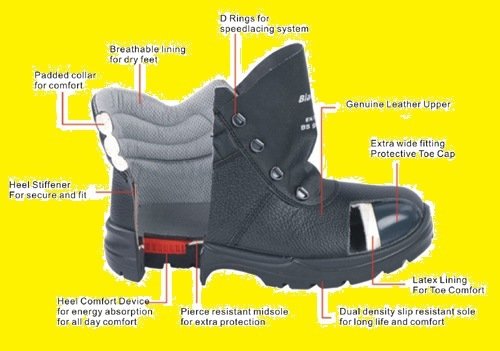
Conductive shoes allow draining of static charge and non-ferrous shoes reduce the possibility of friction sparks and much useful in fire/explosion-prone areas. Conductive footwear resistance should not exceed 450-kilo ohms.
CLICK HERE FOR 👉 HYDRA SAFETY
Conductive shoes are used where floors are non-conductive and grounded such as in the manufacture of certain explosive compounds or while cleaning tanks that have contained solvent or volatile hydrocarbons. These shoes have conductive soles and non-ferrous metal parts.
Foundry workers should wear gaiter or congress-type safety shoes that have no fasteners or lashes and rapidly removable. The tops of the shoes should be covered by full pant leg, spats, or legging to keep out molten metal.
Electricians need insulated shoes with non-metal parts. Leather shoes are useful to work in wet conditions. Wooden soles to walk on hot surfaces and rubber shoes for working with acids and alkalis but not with solvents that dissolve the rubber.
CLICK HERE FOR 👉 PPE IS CODE
Hazard wise selection (Feet Protection PPE)
| Hazards | Protection |
| Falling, rolling objects and materials | Shoes with steel toe-caps |
| Sharp cutting edge, wood chips, glass shards, nails | Steel spring in-soles |
| Chemicals, solvents, alkalis, caustics, bleaches, cutting oils and compounds, grease, creosol. | Non-soluble natural rubber, vinyl, plastic footwear, synthetic rubber, neoprene, cord or cork soles |
| Oily floors | Synthetic rubber or chrome leather soles |
| Hot surfaces, sparks, metal splashes | Heat-resistant soles, slip-on wooden sandals overshoes; foundry boots with elastic band or buckle for quick removal; trouser legs rolled down over boot tops |
| Extreme heat and direct flame | Insulated or |
| Fungal infection from prolonged exposure to water | Lined rubber shoes. Silicone-treated leather or rubber shoes for minor or occasional wetness |
| Sparks can ignite flammable gases, liquids, and explosives | Shoes with non-ferrous metal parts, steel toes covered with a non-sparking material |
| Static electricity built up in the body can ignite volatile material | Shoes with special conductive soles of cork leather etc. |
| Skids and slips surfaces | Cleated, non-slip, or neoprene soles. Slip-on non-skid sandals; strap-on cleats. |
| Live circuits or equipment | Electrically non-conductive standard safety shoes. |
| Sanitation hazards: Contamination and infection | Special plastic over-shoes; paper or shower shoes. Disposable strictly not to be re-used. |
Safety footwear must be carefully chosen for maximum protection and its suitability for the particular hazard. Care and proper maintenance are of vital importance. Footwear must be regularly inspected.
Worn-out or defective shoes should be immediately repaired or replaced. Defective footwear should never be worn. Footwear must always be kept clean and dry.
Material for knee pads, lagging etc
| Material | Protects against | |
| 1. | Asbestos | Sparks, hot materials, and heat. |
| 2. | Chrome Leather | Sparks, hot materials, hot liquids, flying particles, cuts, abrasions. |
| 3. | Flame-Proofed duck | Sparks, hot materials, heat, flying particles, machinery. |
| 4. | Plastic | Dermatitis, hot liquids, moisture, acids, alkalis. |
| 5. | Rubber | Dermatitis, hot liquids, moisture, acids, alkalis, electric shock. |
| 6. | Fiber | Sparks, flying objects, flying particles, cuts, abrasions, machinery. |
| 7. | Chemical resistant fabric | Acids and alkalis. |
| 8. | Hot liquids. |
Material for Shoes and Boots
| Material | Protects against | |
| 1 | Steel toe caps | Falling bodies |
| 2 | Non-skid shoes | Moisture. |
| 3 | Wooden soles | Hot materials, heat, hot liquids, moisture, acids and alkalis, slips and falls, cuts, abrasions. |
| 4 | Chrome leather | Sparks, hot materials, heat, hot liquids |
| 5 | Rubber | Hot liquids, moisture, acids, and alkalis, electric shock |
| 6 | Conductive rubber | Explosive |
Types Available:
- Leather legging and spats.
- Asbestos hip legging.
- Safety leather boots.
- Asbestos clogs or boots with leather sole.
- Rubber gumboots.
- Leather ammunition boots.
- Leather/rubber sole shoes with or without steel toe.
- In Oxford, Jodhpuri or Ankle style.
- Electric shock-proof shoes tested to 11kv.
- Welder’s safety boots.
- Miner’s boots, Hunter’s shoes.
Body, Skin, and Fall Protection PPE:
Body protectors are coats, waist, aprons, overalls, jackets, and complete head-to-toe protective suits. Aprons of different materials are used for protection against blows, splashes, radiant heat, flying particles, etc.
Pads are used to protect the shoulders and back from bruises. Impervious clothing of rubber or synthetic fabrics is used for protection against water, moisture, dust, vapors, and liquid chemicals.
CLICK HERE FOR 👉 WORK AT HEIGHT SAFETY
The nature of the potential hazard degree of the hazard involved and the nature of activities of the wearer
Although complete coverage of the body and legs is not needed in many cases, unnecessary safety clothing may hamper the efficiency of the wearer. No compromise should be made with strict safety requirements.
Selection is as follows:
| Material | Protects against | |
| 1. | Asbestos | Sparks, hot materials, heat. |
| 2. | Chrome leather | Sparks, hot materials, hot liquids, flying particles, cuts, abrasions. |
| 3. | Plastic or Rubber | Hot liquids, moisture, acids and alkalis, electric shock, dermatitis, machinery. |
| 4. | Canvas | Flying particles, cuts, abrasions, machinery |
| 5. | Chemical resistant fabric | Acid and alkalis. |
| 6. | Reflective fabric | Hot liquids. |
Types of body protection PPE available are:
Body Protection:- Lather combination suit, hood, clogs, boots, and gloves, mittens, aprons, spats, leggings, furnace mask, rubber apron with hood combined, low weight rubber-coated fabric suit, low weight PVC coated fabric suit, heavy-duty PVC suit or rubber-coated fabric suit, PVC or rubber-coated aprons with sleeves, sand or shot blast helmet, rubber mat for electrical purpose, vulcanized fiber face mask for radiant heat, PVC splash-proof coat, PVC hood with protected ventilator, PVC pressure suit, PVC boiler suit, overall, coat-pant and hood.
Special work clothing includes leather or wool clothing, asbestos or aluminized clothing, and flame-retardant or fireproof work cloths.
Safety Belt:- Lineman leather belt, leather safety strap or belt, full-body harness, man-hoisting leather belt, Quick-on coverall harness, Suspension harness, Wrist rescue system, Descent system, Total encapsulating suit harness, Linemen’s belts, Structural steelworker’s, car dropper’s and derrick worker’s belts, Shock-absorbing lanyards, Retractable Lanyard, Retractable lifeline, Winches, Rope grabs, Horizontal lifeline system, Rail slider anchorage connector, Sure-hold confined space positioning equipment or system.
CLICK HERE FOR 👉 RADIATION SAFETY
Fall protection
Fall Protection for the body includes safety belts, lifelines (ropes) and lanyards, harnesses (belts & straps with buckles) and fall-arrester devices or safety nets.

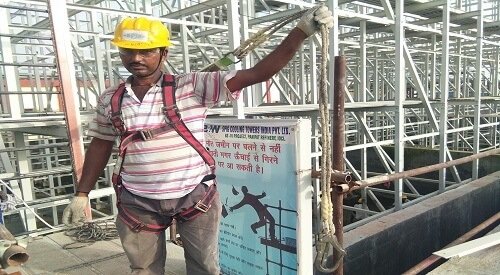
It is important to note that such safety belts and associated equipment are used when fall hazards cannot be eliminated by strong support like railings, floors, platforms, etc.
OSHA Standard has prohibited the use of a body belt only for fall arrest and a fall arrest system is suggested, since 1-1-1998.
Body belts are used where less than 1 m free fall is Full body harness anticipated and a body with safety belt and harness (belts or straps on fall arrester device chest, shoulders, and thighs) is used for a limited fall up to 2 m. A harness can spread the shock load over the shoulders, thighs, and seat (hips).
The body belt or lifeline D-ring should be arranged at the back of the worker. The wearer of the safety belt should not tie off below the waist level (to prevent turning down the head). A window cleaner’s belt length is limited to 8 ft (2.5m). The chest belt is worn loosely to allow smooth breathing.
The lifeline may be vertical from a fixed anchorage or horizontal between two fixed anchorage
Horizontal Lifeline
Independent of the work surfaces Lanyard is a flexible line up to 6 ft (1.8 m) to secure the wearer’s harness (D-ring) to a lifeline or fixed anchorage. Lanyards may be made of nylon or other fibrous or metallic material and are non-stretchable to limit free fall distance.
CLICK HERE FOR 👉 SAFETY HARNESS/BELT CAPACITY
Shock-absorber lanyards are available to absorb up to 80% of the stopping force of a normal lanyard. The metal lanyard must not be used where the electrical hazard is possible. Snap hooks (locking type referable) and D-ring should be maintained in good condition. Knots or lengthening of lanyards must be avoided.
Body belts (work belts) are used to reduce the probability of falls. Chest harnesses are used where there is limited fall hazard (not vertical free fall) such as for the removal of a person from a tank or bin. Body harnesses, covering the chest, shoulders, and thighs, are used to arrest the most severe free falls.
The retrieval method is necessary to shorten the hanging distance after a fall up to 6ft (maximum limit of free fail for more fall height, other supporting fixed structure must be provided by fencing, railing, platform, fixed-ladder with platform and handrails, etc.) A retractable lifeline, which will be shortened automatically (Spring action) after its full length, can limit falls to inches and avoid prolonged suspension causing high discomfort to a hanging person.
Fall arrester net, if used, should be tied firmly as near as possible under the working place to minimize the fall distance.
CLICK HERE FOR 👉 FULL-BODY SAFETY HARNESS
Belts, Safety Harness harnesses, lifelines, lanyards, buckles, joints, D-ring, etc. should be checked for weak points, washed regularly and kept
I hope you understand the facts about PPE (PERSONAL PROTECTIVE EQUIPMENT). if you have any doubts regarding this article please comment below. If you like this article please share it with your HSE friends.
Also, read this:
? PLEASE SHARE THIS ARTICLE WITH YOUR RELEVANT FRIENDS?



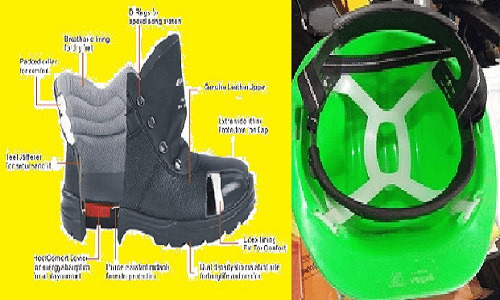
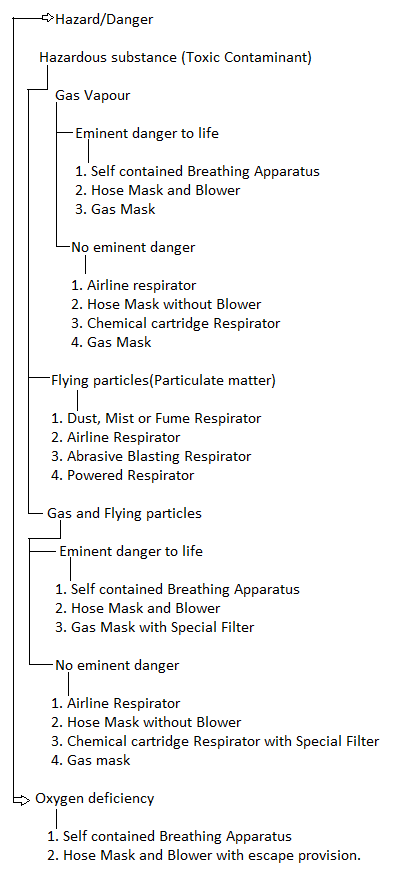



Great, Noble work.
very helpful ………
Thank You!!
This great.